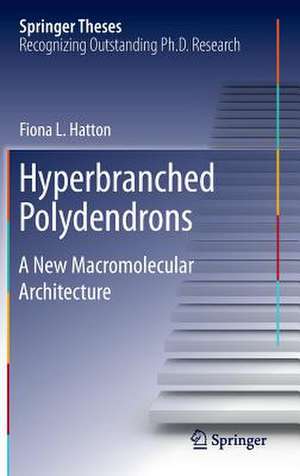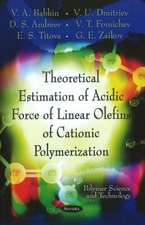Hyperbranched Polydendrons: A New Macromolecular Architecture: Springer Theses
Autor Fiona L. Hattonen Limba Engleză Hardback – iun 2015
| Toate formatele și edițiile | Preț | Express |
|---|---|---|
| Paperback (1) | 639.73 lei 43-57 zile | |
| Springer International Publishing – 9 oct 2016 | 639.73 lei 43-57 zile | |
| Hardback (1) | 646.11 lei 43-57 zile | |
| Springer International Publishing – iun 2015 | 646.11 lei 43-57 zile |
Din seria Springer Theses
- 18%
 Preț: 997.88 lei
Preț: 997.88 lei -
 Preț: 389.88 lei
Preț: 389.88 lei - 15%
 Preț: 646.94 lei
Preț: 646.94 lei - 18%
 Preț: 943.43 lei
Preț: 943.43 lei -
 Preț: 399.29 lei
Preț: 399.29 lei - 18%
 Preț: 944.99 lei
Preț: 944.99 lei - 15%
 Preț: 636.80 lei
Preț: 636.80 lei - 18%
 Preț: 941.05 lei
Preț: 941.05 lei - 15%
 Preț: 643.16 lei
Preț: 643.16 lei - 15%
 Preț: 642.68 lei
Preț: 642.68 lei - 18%
 Preț: 1103.62 lei
Preț: 1103.62 lei - 20%
 Preț: 558.82 lei
Preț: 558.82 lei - 18%
 Preț: 1112.30 lei
Preț: 1112.30 lei - 18%
 Preț: 944.19 lei
Preț: 944.19 lei - 18%
 Preț: 1109.92 lei
Preț: 1109.92 lei - 18%
 Preț: 1217.27 lei
Preț: 1217.27 lei - 15%
 Preț: 640.06 lei
Preț: 640.06 lei - 15%
 Preț: 636.45 lei
Preț: 636.45 lei - 15%
 Preț: 640.06 lei
Preț: 640.06 lei - 15%
 Preț: 640.88 lei
Preț: 640.88 lei -
 Preț: 389.70 lei
Preț: 389.70 lei - 20%
 Preț: 563.89 lei
Preț: 563.89 lei -
 Preț: 393.35 lei
Preț: 393.35 lei - 15%
 Preț: 637.93 lei
Preț: 637.93 lei - 15%
 Preț: 641.85 lei
Preț: 641.85 lei - 18%
 Preț: 1225.94 lei
Preț: 1225.94 lei - 20%
 Preț: 551.36 lei
Preț: 551.36 lei - 18%
 Preț: 1229.10 lei
Preț: 1229.10 lei - 15%
 Preț: 639.25 lei
Preț: 639.25 lei - 18%
 Preț: 999.45 lei
Preț: 999.45 lei - 15%
 Preț: 640.06 lei
Preț: 640.06 lei - 18%
 Preț: 1220.45 lei
Preț: 1220.45 lei - 18%
 Preț: 1116.26 lei
Preț: 1116.26 lei - 18%
 Preț: 1110.72 lei
Preț: 1110.72 lei - 18%
 Preț: 1000.87 lei
Preț: 1000.87 lei - 18%
 Preț: 891.17 lei
Preț: 891.17 lei - 15%
 Preț: 640.06 lei
Preț: 640.06 lei - 5%
 Preț: 1154.07 lei
Preț: 1154.07 lei - 15%
 Preț: 635.96 lei
Preț: 635.96 lei - 15%
 Preț: 640.88 lei
Preț: 640.88 lei -
 Preț: 387.20 lei
Preț: 387.20 lei - 18%
 Preț: 1109.92 lei
Preț: 1109.92 lei -
 Preț: 385.25 lei
Preț: 385.25 lei -
 Preț: 385.25 lei
Preț: 385.25 lei - 18%
 Preț: 1112.30 lei
Preț: 1112.30 lei - 18%
 Preț: 999.45 lei
Preț: 999.45 lei -
 Preț: 386.99 lei
Preț: 386.99 lei - 15%
 Preț: 637.13 lei
Preț: 637.13 lei - 20%
 Preț: 554.20 lei
Preț: 554.20 lei - 20%
 Preț: 555.57 lei
Preț: 555.57 lei
Preț: 646.11 lei
Preț vechi: 760.13 lei
-15% Nou
Puncte Express: 969
Preț estimativ în valută:
123.63€ • 129.41$ • 102.90£
123.63€ • 129.41$ • 102.90£
Carte tipărită la comandă
Livrare economică 31 martie-14 aprilie
Preluare comenzi: 021 569.72.76
Specificații
ISBN-13: 9783319187525
ISBN-10: 331918752X
Pagini: 260
Ilustrații: XXII, 260 p. 218 illus., 9 illus. in color.
Dimensiuni: 155 x 235 x 22 mm
Greutate: 0.58 kg
Ediția:2015
Editura: Springer International Publishing
Colecția Springer
Seria Springer Theses
Locul publicării:Cham, Switzerland
ISBN-10: 331918752X
Pagini: 260
Ilustrații: XXII, 260 p. 218 illus., 9 illus. in color.
Dimensiuni: 155 x 235 x 22 mm
Greutate: 0.58 kg
Ediția:2015
Editura: Springer International Publishing
Colecția Springer
Seria Springer Theses
Locul publicării:Cham, Switzerland
Public țintă
ResearchCuprins
Introduction.- Synthesis and characterisation of hyp-polydendron materials and subsequent anoparticle formation.- Mixing dendron and PEG initiators for the polymerisation of branched pHPMA and aqueous nanoparticle formation.- Mixing dendron and PEG initiators for the polymerisation of branched pHPMA and formation of sterically stabilised nanoparticles.- Hyp-Polydendrons; studies of nanoprecipitation behavior.- Conclusions and Future work.- Experimental.
Notă biografică
Dr. Fiona L. Hatton obtained a 1st class MChem degree in medicinal chemistry and pharmacology from the University of Liverpool, UK, 2010. She received her PhD in 2014 from the same university, under the supervision of Prof. Steve Rannard, specializing in polymer chemistry, more specifically hyperbranched polydendrons. Fiona joined the division of Coating Technology, KTH Royal Institute of Technology, Sweden in 2014 as a postdoctoral researcher working for associate professor Anna Carlmark.
Textul de pe ultima copertă
This thesis outlines the first synthesis of a new complex branched polymer architecture that aims to combine the benefits of dendrimers with the simplicity of conventional polymerisation. There is no other available literature on these remarkable materials, dubbed hyperbranched polydendrons, due to their novelty. The new materials were shown to have very high molecular weights (>1,000,000 g/mol), exceptional self-assembly and encapsulation behaviour and unparalleled functionalisation capabilities, and were studied pharmacologically to determine their potential as oral nanomedicine candidates. The detailed investigation of the chemical variables involved in synthesising hyperbranched polydendrons has shown that their self-assembly and pharmacological behaviour can be turned on and off and fine-tuned by altering the composition of the materials. The permeation of the self-assembled particles through model gut epithelium suggests the potential for oral dosing of drug loaded nanomedicines that result in circulating nanoparticles – a research goal that is currently being pursued by several groups around the globe.
Caracteristici
Nominated as an outstanding PhD thesis by the University of Liverpool, UK Describes the development of a new class of materials, hyperbranched polydendrons Examines hyperbranched polydendrons that formed nanoparticles with controlled size and functionality Includes preliminary pharmacological evaluations, revealing that the particles formed are nontoxic and could potentially be used in orally administrated nanomedicines Includes supplementary material: sn.pub/extras











